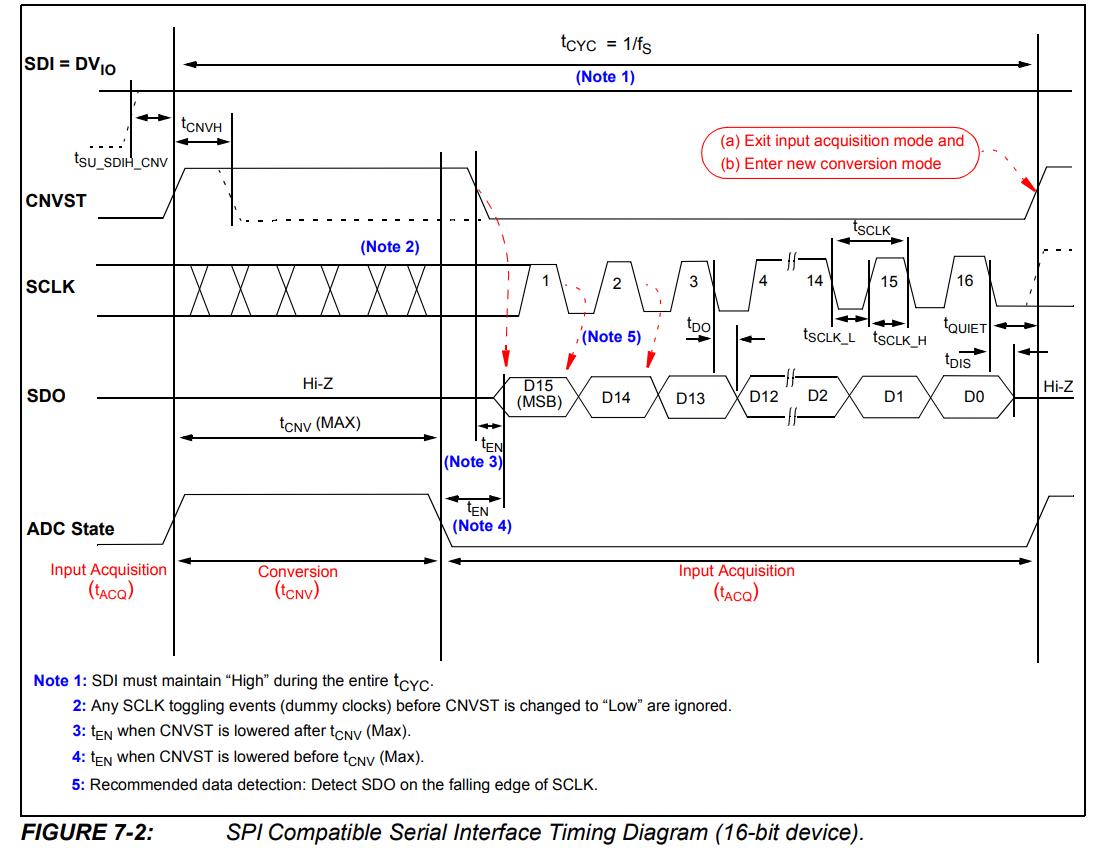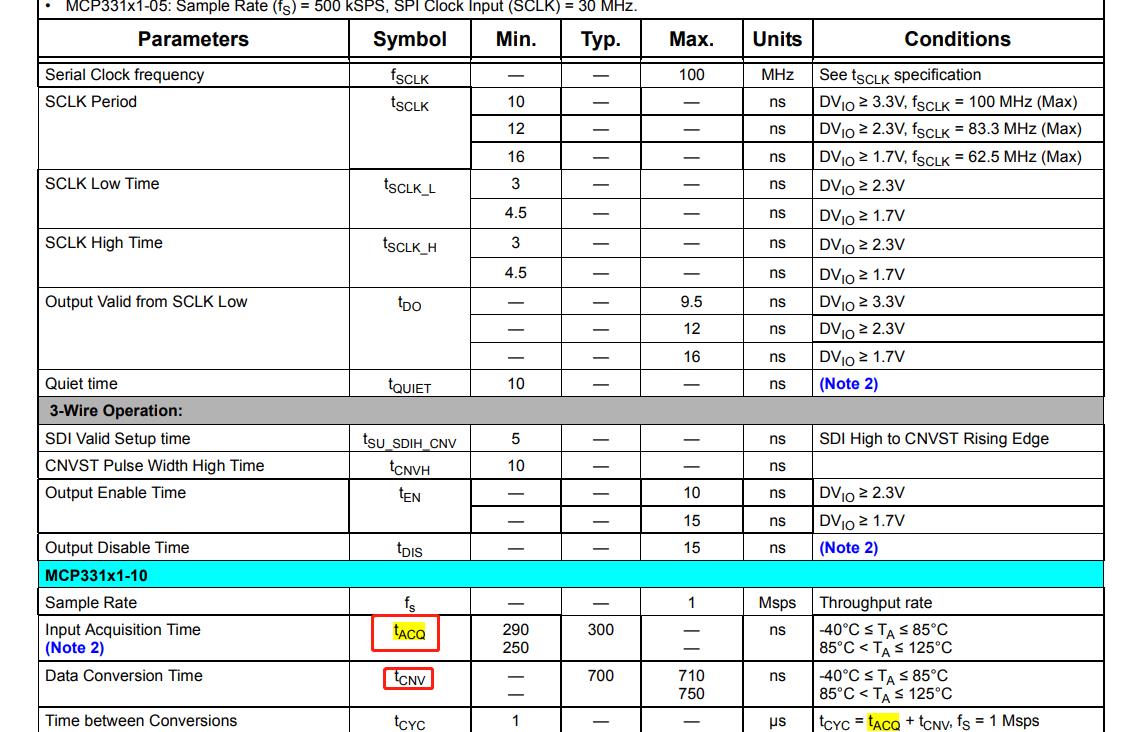基于MCP3313-10 ADC 的SPI接口驱动练习
Posted 好记性不如烂笔头
tags:
篇首语:本文由小常识网(cha138.com)小编为大家整理,主要介绍了基于MCP3313-10 ADC 的SPI接口驱动练习相关的知识,希望对你有一定的参考价值。
先了解MCP3313-10的操作步骤:

看上图可以了解,上电之后先经过tACQ(输入采集,但这个时候并不能对数据进行采集)一段时间,设定为状态0;再进入tCNV(数据转换期间,不能采集数据),设定为状态1;最后在进入tACQ(可以进行数据采集),设定位状态2。状态1-2-1-2之间进行轮回。
然后查看具体时序:

CNVST 初始值为低,经过tACQ在上升沿到来时,adc进入数据转换,转换时间需要tCNV,然后进入数据采集,采集时间tACQ,所以需要知道这几个具体时间
tACQ 有一个最小值290ns,没标最大值,说明这个时间可以更长点
tCNV有标最大值,没标最小时值,说明这个时间可以短点

OK 确认之后,可以对计数器进行设计了。一共需要两个计数器,一个计数器产生sclk,另外一个计数器需对数据采集个数进行计数。由于转换期间和数据采集期间的时间不一样,不会同时计数,所以可以重复利用一个计数器,引入一个变量x.
上电时的tACQ ,和数据转换后的tACQ 时间是一样,计数器也可以共用一个。代码如下:
always @(posedge clk or negedge rst_n)begin if(!rst_n)begin cnt0 <= 0; end else if(add_cnt0)begin if(end_cnt0)begin cnt0 <= 0; end else begin cnt0 <= cnt0 + 1; end end end assign add_cnt0 = flag_add; assign end_cnt0 = add_cnt0 && cnt0 == 4 - 1; //输入时钟50M,4分屏,sclk = 50/4 = 12.5M always @(posedge clk or negedge rst_n)begin if(!rst_n)begin cnt1 <= 0; end else if(add_cnt1)begin if(end_cnt1)begin cnt1 <= 0; end else begin cnt1 <= cnt1 + 1; end end end assign add_cnt1 = end_cnt0; assign end_cnt1 = add_cnt1 && cnt1 == x - 1; always @(*)begin if(state == 0)begin x = 16; //tACQ:等待16 * 80 = 1280 ns end else if(state == 1)begin x = 8; //tCNV:等待8 * 80 = 640 ns , end else begin x = 16; //tACQ:等待16 * 80 = 1280 ns end end
引入了一个状态机,上电时进入state =0 状态,数据转换进入state =1 状态,数据采集进入state =2 状态
always @(posedge clk or negedge rst_n)begin if(!rst_n)begin state <= 0; flag_add <= 0; adc_cs <= 0; flag_sel <= 0; dout_vld <= 0; end else case(state) 0: begin flag_add <= 1; adc_cs <= 0; flag_sel <= 0; dout_vld <= 0; if(end_cnt1)begin //等待16 * 80 = 1280 ns state <= 1; adc_cs <= 1; flag_sel <= 0; dout_vld <= 0; end end 1: begin //adc数据在转换中 adc_cs <= 1; flag_sel <= 0; dout_vld <= 0; if(end_cnt1)begin //等待8*80 = 640 ns state <= 2; adc_cs <= 0; flag_sel <= 1; dout_vld <= 0; end end 2: begin // 数据采集期间 adc_cs <= 0; flag_sel <= 1; dout_vld <= 0; if(end_cnt1)begin //等待16 * 80 = 1280 ns,数据采集完进入下一轮转换 state <= 1; adc_cs <= 1; flag_sel <= 0; dout_vld <= 1; end end default: state <= 0; endcase end
引入了几个信号:
flag_add: 计数器启动条件,这里设置为1,计数器一直计数
flag_sel:将数据采集那段时间进行标注,用于区分哪段时间需要进行采数据
dout_vld:数据采集完产生一个有效标志,然后对一个完整数据进行锁存
always @(posedge clk or negedge rst_n)begin if(!rst_n)begin adc_data_temp <= 0; end else if(flag_sel == 1 && add_cnt0 && cnt0 == 2-1 && cnt1 >= 0 && cnt1 < 16)begin //在sclk的下降沿采数据,同时在flag_sel有效期间 adc_data_temp[15-cnt1] <= adc_sdo; end end always @(posedge clk or negedge rst_n)begin if(!rst_n)begin adc_data <= 0; end else if(dout_vld)begin //一个完整的16bit数据采集完 adc_data <= adc_data_temp; end end
然后产生sclk时钟:
always @(posedge clk or negedge rst_n)begin if(!rst_n)begin adc_sclk <= 1; end else if(add_cnt0 && cnt0 == 2-1)begin adc_sclk <= 0; end else if(end_cnt0)begin adc_sclk <= 1; end end
完整代码:


module mcp3313_10_test( clk, rst_n, adc_sdo, adc_cs, adc_sclk, adc_data ); input clk; input rst_n; input adc_sdo; output adc_cs; output adc_sclk; output [16-1 : 0] adc_data; reg [16-1 : 0] adc_data_temp; reg [16-1 : 0] adc_data; reg [3 -1 : 0] cnt0/* synthesis keep*/; reg [6 -1 : 0] cnt1/* synthesis keep*/; reg [6 -1 : 0] x/* synthesis keep*/; reg [2 -1 : 0] state/* synthesis keep*/; reg flag_add; reg flag_sel; reg dout_vld; reg adc_cs; reg adc_sclk; wire add_cnt0; wire end_cnt0; wire add_cnt1; wire end_cnt1; always @(posedge clk or negedge rst_n)begin if(!rst_n)begin cnt0 <= 0; end else if(add_cnt0)begin if(end_cnt0)begin cnt0 <= 0; end else begin cnt0 <= cnt0 + 1; end end end assign add_cnt0 = flag_add; assign end_cnt0 = add_cnt0 && cnt0 == 4 - 1; //输入时钟50M,4分屏,sclk = 50/4 = 12.5M always @(posedge clk or negedge rst_n)begin if(!rst_n)begin cnt1 <= 0; end else if(add_cnt1)begin if(end_cnt1)begin cnt1 <= 0; end else begin cnt1 <= cnt1 + 1; end end end assign add_cnt1 = end_cnt0; assign end_cnt1 = add_cnt1 && cnt1 == x - 1; always @(*)begin if(state == 0)begin x = 16; //tACQ:等待16 * 80 = 1280 ns end else if(state == 1)begin x = 8; //tCNV:等待8 * 80 = 640 ns , end else begin x = 16; //tACQ:等待16 * 80 = 1280 ns end end always @(posedge clk or negedge rst_n)begin if(!rst_n)begin state <= 0; flag_add <= 0; adc_cs <= 0; flag_sel <= 0; dout_vld <= 0; end else case(state) 0: begin flag_add <= 1; adc_cs <= 0; flag_sel <= 0; dout_vld <= 0; if(end_cnt1)begin //等待16 * 80 = 1280 ns state <= 1; adc_cs <= 1; flag_sel <= 0; dout_vld <= 0; end end 1: begin //adc数据在转换中 adc_cs <= 1; flag_sel <= 0; dout_vld <= 0; if(end_cnt1)begin //等待8*80 = 640 ns state <= 2; adc_cs <= 0; flag_sel <= 1; dout_vld <= 0; end end 2: begin // 数据采集期间 adc_cs <= 0; flag_sel <= 1; dout_vld <= 0; if(end_cnt1)begin //等待16 * 80 = 1280 ns,数据采集完进入下一轮转换 state <= 1; adc_cs <= 1; flag_sel <= 0; dout_vld <= 1; end end default: state <= 0; endcase end always @(posedge clk or negedge rst_n)begin if(!rst_n)begin adc_data_temp <= 0; end else if(flag_sel == 1 && add_cnt0 && cnt0 == 2-1 && cnt1 >= 0 && cnt1 < 16)begin //在sclk的下降沿采数据,同时在flag_sel有效期间 adc_data_temp[15-cnt1] <= adc_sdo; end end always @(posedge clk or negedge rst_n)begin if(!rst_n)begin adc_data <= 0; end else if(dout_vld)begin //一个完整的16bit数据采集完 adc_data <= adc_data_temp; end end always @(posedge clk or negedge rst_n)begin if(!rst_n)begin adc_sclk <= 1; end else if(add_cnt0 && cnt0 == 2-1)begin adc_sclk <= 0; end else if(end_cnt0)begin adc_sclk <= 1; end end endmodule
SignalTap II Logic Analyzer 抓取波形如下:

以上是关于基于MCP3313-10 ADC 的SPI接口驱动练习的主要内容,如果未能解决你的问题,请参考以下文章